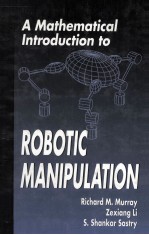

A Mathematical Introduction to ROBOTIC MANIPULATIONPDF电子书下载
- 电子书积分:15 积分如何计算积分?
- 作 者:
- 出 版 社:Inc
- 出版年份:1994
- ISBN:0849379814
- 页数:456 页
Chapter 1 Introduction 1
1 Brief History 1
2 Multifingered Hands and Dextrous Manipulation 8
3 Outline of the Book 13
3.1 Manipulation using single robots 14
3.2 Coordinated manipulation using multifingered robot hands 15
3.3 Nonholonomic behavior in robotic systems 16
4 Bibliography 18
Chapter 2 Rigid Body Motion 19
1 Rigid Body Transformations 20
2 Rotational Motion in R3 22
2.1 Properties of rotation matrices 23
2.2 Exponential coordinates for rotation 27
2.3 Other representations 31
3 Rigid Motion in R3 34
3.1 Homogeneous representation 36
3.2 Exponential coordinates for rigid motion and twists 39
3.3 Screws:a geometric description of twists 45
4 Velocity of a Rigid Body 51
4.1 Rotational velocity 51
4.2 Rigid body velocity 54
4.3 Velocity of a screw motion 58
4.4 Coordinate transformations 59
5 Wrenches and Reciprocal Screws 61
5.1 Wrenches 61
5.2 Screw coordinates for a wrench 65
5.3 Reciprocal screws 66
6 Summary 70
7 Bibliography 72
8 Exercises 73
Chapter 3 Manipulator Kinematics 81
1 Introduction 81
2 Forward Kinematics 83
2.1 Problem statement 83
2.2 The product of exponentials formula 85
2.3 Parameterization of manipulators via twists 91
2.4 Manipulator workspace 95
3 Inverse Kinematics 97
3.1 A planar example 97
3.2 Paden-Kahan subproblems 99
3.3 Solving inverse kinematics using subproblems 104
3.4 General solutions to inverse kinematics problems 108
4 The Manipulator Jacobian 115
4.1 End-effector velocity 115
4.2 End-effector forces 121
4.3 Singularities 123
4.4 Manipulability 128
5 Redundant and Parallel Manipulators 129
5.1 Redundant manipulators 130
5.2 Parallel manipulators 132
5.3 Four-bar linkage 135
5.4 Stewart platform 139
6 Summary 144
7 Bibliography 146
8 Exercises 147
Chapter 4 Robot Dynamics and Control 155
1 Introduction 155
2 Lagrange’s Equations 156
2.1 Basic formulation 157
2.2 Inertial properties of rigid bodies 160
2.3 Example:Dynamics of a two-link planar robot 164
2.4 Newton-Euler equations for a rigid body 165
3 Dynamics of Open-Chain Manipulators 168
3.1 The Lagrangian for an open-chain robot 168
3.2 Equations of motion for an open-chain manipulator 169
3.3 Robot dynamics and the product of exponentials formula 175
4 Lyapunov Stability Theory 179
4.1 Basic definitions 179
4.2 The direct method of Lyapunov 182
4.3 The indirect method of Lyapunov 184
4.4 Examples 185
4.5 Lasalle’s invariance principle 188
5 Position Control and Trajectory Tracking 190
5.1 Problem description 190
5.2 Computed torque 191
5.3 PD control 193
5.4 Workspace control 196
6 Control of Constrained Manipulators 199
6.1 Dynamics of constrained systems 200
6.2 Control of constrained manipulators 202
6.3 Example:A planar manipulator moving in a slot 203
7 Summary 206
8 Bibliography 207
9 Exercises 208
Chapter 5 Multifingered Hand Kinematics 211
1 Introduction to Grasping 211
2 Grasp Statics 214
2.1 Contact models 214
2.2 The grasp map 218
3 Force-Closure 223
3.1 Formal definition 223
3.2 Constructive force-closure conditions 224
4 Grasp Planning 229
4.1 Bounds on number of required contacts 229
4.2 Constructing force-closure grasps 232
5 Grasp Constraints 234
5.1 Finger kinematics 234
5.2 Properties of a multifingered grasp 237
5.3 Example:Two SCARA fingers grasping a box 240
6 Rolling Contact Kinematics 243
6.1 Surface models 243
6.2 Contact kinematics 248
6.3 Grasp kinematics with rolling 253
7 Summary 256
8 Bibliography 257
9 Exercises 259
Chapter 6 Hand Dynamics and Control 265
1 Lagrange’s Equations with Constraints 265
1.1 Pfaffian constraints 266
1.2 Lagrange multipliers 269
1.3 Lagrange-d’Alembert formulation 271
1.4 The nature of nonholonomic constraints 274
2 Robot Hand Dynamics 276
2.1 Derivation and properties 276
2.2 Internal forces 279
2.3 Other robot systems 281
3 Redundant and Nonmanipulable Robot Systems 285
3.1 Dynamics of redundant manipulators 286
3.2 Nonmanipulable grasps 290
3.3 Example:Two-fingered SCARA grasp 291
4 Kinematics and Statics of Tendon Actuation 293
4.1 Inelastic tendons 294
4.2 Elastic tendons 296
4.3 Analysis and control of tendon-driven fingers 298
5 Control of Robot Hands 300
5.1 Extending controllers 300
5.2 Hierarchical control structures 302
6 Summary 311
7 Bibliography 313
8 Exercises 314
Chapter 7 Nonholonomic Behavior in Robotic Systems 317
1 Introduction 317
2 Controllability and Frobenius’ Theorem 321
2.1 Vector fields and flows 322
2.2 Lie brackets and Frobenius’ theorem 323
2.3 Nonlinear Controllability 329
3 Examples of Nonholonomic Systems 332
4 Structure of Nonholonomic Systems 339
4.1 Classification of nonholonomic distributions 340
4.2 Examples of nonholonomic systems,continued 341
4.3 Philip Hall basis 344
5 Summary 346
6 Bibliography 347
7 Exercises 349
Chapter 8 Nonholonomic Motion Planning 355
1 Introduction 355
2 Steering Model Control Systems Using Sinusoids 358
2.1 First-order controllable systems:Brockett’s system 358
2.2 Second-order controllable systems 362
2.3 Higher-order systems:chained form systems 363
3 General Methods for Steering 366
3.1 Fourier techniques 367
3.2 Conversion to chained form 369
3.3 Optimal steering of nonholonomic systems 371
3.4 Steering with piecewise constant inputs 375
4 Dynamic Finger Repositioning 382
4.1 Problem description 382
4.2 Steering using sinusoids 383
4.3 Geometric phase algorithm 384
5 Summary 389
6 Bibliography 390
7 Exercises 391
Chapter 9 Future Prospects 395
1 Robots in Hazardous Environments 396
2 Medical Applications for Multifingered Hands 398
3 Robots on a Small Scale:Microrobotics 399
Appendix A Lie Groups and Robot Kinematics 403
1 Differentiable Manifolds 403
1.1 Manifolds and maps 403
1.2 Tangent spaces and tangent maps 404
1.3 Cotangent spaces and cotangent maps 405
1.4 Vector fields 406
1.5 Differential forms 408
2 Lie Groups 408
2.1 Definition and examples 408
2.2 The Lie algebra associated with a Lie group 410
2.3 The exponential map 412
2.4 Canonical coordinates on a Lie group 414
2.5 Actions of Lie groups 415
3 The Geometry of the Euclidean Group 416
3.1 Basic properties 416
3.2 Metric properties of SE(3) 422
3.3 Volume forms on SE(3) 430
Appendix B A Mathematica Package for Screw Calculus 435
Bibliography 441
Index 449
